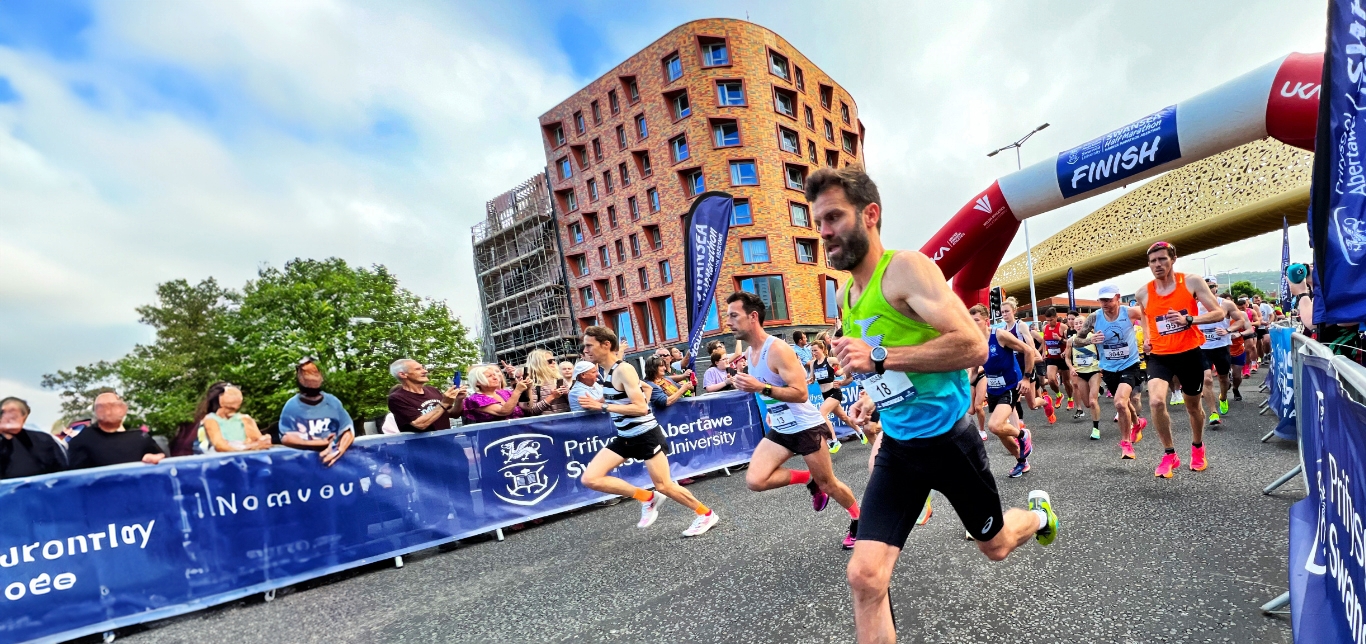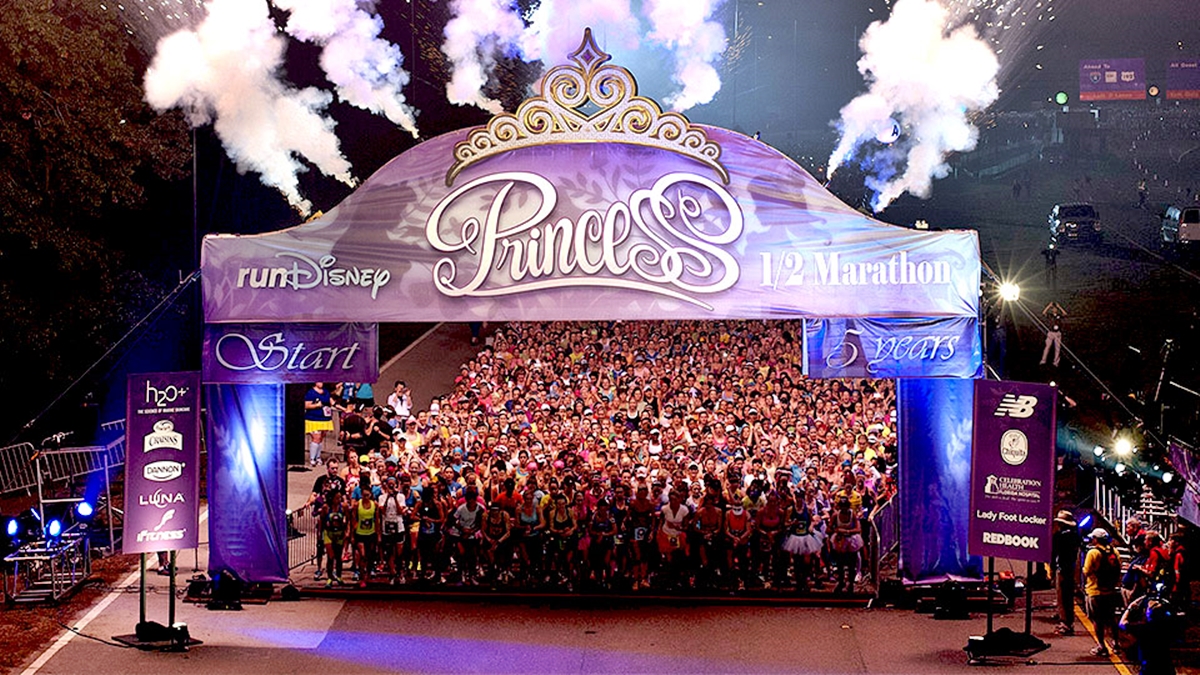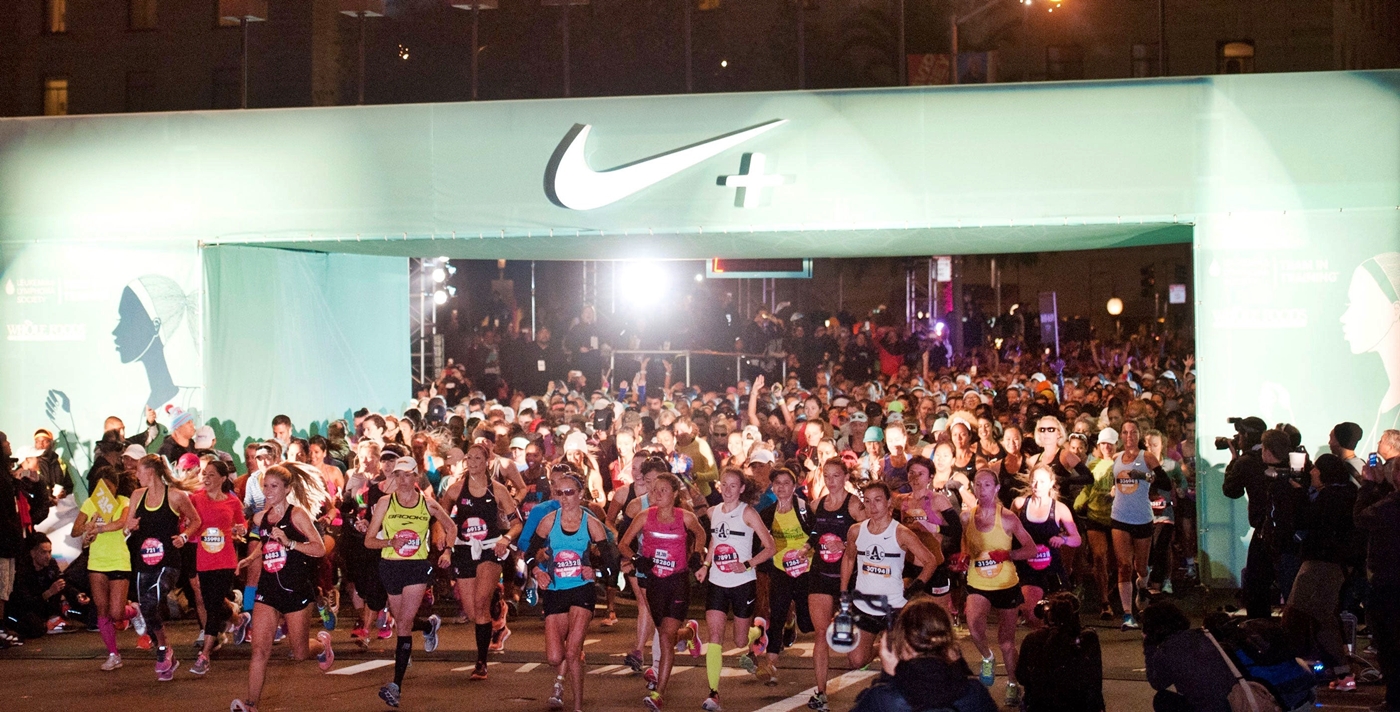Home>Misc>Featured>What Happens To Your Body During A Marathon


Featured
What Happens To Your Body During A Marathon
Modified: January 2, 2024
Discover what happens to your body when you take on the challenge of running a marathon. Featured insights on the physical and mental transformations you'll experience during this ultimate test of endurance.
Introduction
Marathons are not just a test of physical endurance; they also provide a unique glimpse into the incredible things our bodies are capable of. In this article, we will take a closer look at what happens to your body during a marathon, from the moment you line up at the starting line to that triumphant crossing of the finish line. Get ready for an exhilarating journey through the physiological and psychological challenges faced by runners during this ultimate test of strength and determination.
Preparing for a marathon requires months of training, dedication, and mental fortitude. It’s not just about building stamina and endurance; runners must also focus on nutrition, rest, and recovery. With proper preparation, the body is primed to take on the grueling 26.2-mile challenge.
As the race begins, the adrenaline kicks in, preparing the body for the intense physical effort ahead. Muscles warm up, blood flow increases, and the heart rate starts to rise. The first mile is all about finding your groove and settling into a comfortable pace. It’s the calm before the storm, where runners establish their rhythm and mentally prepare for the long journey ahead.
As the race progresses, the body goes through various stages of fatigue and endurance. Fueling and hydration play a crucial role in maintaining energy levels and preventing muscle cramps. Runners need to strike a delicate balance between consuming enough calories and fluids without causing digestive discomfort.
Around mile 11 to 15, physical fatigue begins to set in. Muscles start feeling heavy, and runners may experience discomfort or even minor injuries. This is where mental strength becomes essential. Pushing through the pain and focusing on the end goal becomes a crucial factor in a runner’s success.
Mile 16 to 20 is often referred to as the notorious “wall” that runners face. It’s a mental and emotional challenge where doubt and fatigue try to take over. But with determination and mental resilience, runners can push past this wall and find a second wind.
Mile 21 to 25 is a testament to the power of the human spirit. Despite the physical and mental exhaustion, runners find the strength to keep going, spurred on by the cheers of the crowd and the anticipation of the finish line. Every step is a triumph over pain and doubt.
Finally, as runners approach mile 26, they can see the finish line in sight. The adrenaline surges through their bodies, and a surge of energy powers the final sprint. Crossing the finish line is a culmination of months of hard work and dedication. It’s an emotional and exhilarating moment that highlights the extraordinary capabilities of the human body.
After the race, proper post-marathon recovery is crucial to allow the body to rest and heal. Runners should prioritize hydration, stretching, and gentle exercises to promote blood flow and muscle recovery. Gradually easing back into regular training will help prevent injuries and allow the body to regain its strength and stamina.
Get ready to dive deep into the incredible physical and mental journey of a marathon. Strap on your running shoes, hydrate, and let’s explore the remarkable things that happen to your body during those 26.2 miles!
Preparation for a Marathon
Preparing for a marathon is a challenging and rewarding process that requires careful planning and dedication. Months of training, both physically and mentally, are essential to ensure a successful race day. Let’s explore the key aspects of marathon preparation.
First and foremost, setting a training schedule is crucial. It’s recommended to start training at least 12 to 16 weeks before the marathon. This allows for progressive buildup of mileage and endurance. A well-structured training plan typically includes a mix of long runs, speed work, tempo runs, and rest days to prevent overexertion and minimize the risk of injury.
In addition to consistent running, cross-training plays an important role in preparing the body for a marathon. Activities like cycling, swimming, or strength training can help build overall fitness, strengthen muscles, and prevent muscle imbalances. These activities also provide a break from the repetitive impact of running and can contribute to injury prevention.
Nutrition is another vital component of marathon training. Fueling the body with the right nutrients ensures optimal performance and aids in recovery. It’s important to focus on a balanced diet that includes carbohydrates for energy, protein for muscle repair, and healthy fats for overall wellness. Hydration should also be a priority, both during training and on race day.
Rest and recovery are often underestimated but are crucial for allowing the body to adapt and repair. Proper sleep is essential for muscle recovery, hormone regulation, and mental well-being. Additionally, incorporating rest days into the training schedule helps prevent overtraining, reduces the risk of injury, and ensures that the body is adequately prepared for the demands of race day.
Mental preparation is equally important as physical training. The psychological challenges of running a marathon can be significant, so developing mental resilience is key. Techniques like visualization, positive self-talk, and setting achievable goals can help maintain focus and motivation throughout the training process and on race day.
Another aspect of marathon preparation is familiarizing yourself with the race course. Studying the course map, elevation profile, and learning about any challenging sections can give you a strategic advantage on race day. It’s also a good idea to practice running on similar terrain and inclines during training to build confidence and mental preparedness.
Finally, having the right gear is essential for a comfortable and successful marathon experience. Invest in proper running shoes that provide adequate support and cushioning for your feet. Test out various apparel options during training to find what works best for you in terms of comfort, moisture-wicking, and temperature regulation.
Preparing for a marathon is not just about physical fitness; it’s a holistic approach that encompasses nutrition, rest, mental preparation, and attention to detail. By following a well-structured training plan, fueling your body properly, and taking care of your overall health, you’ll be ready to tackle the marathon with confidence and determination.
Mile 1: Warm-up and Starting Line
Welcome to the start of your marathon journey! Mile 1 is a critical moment as it sets the tone for the entire race. This section will focus on the warm-up process and the excitement that builds up at the starting line.
Before the race officially begins, it’s crucial to warm up your body and prepare it for the intense physical effort ahead. A warm-up typically consists of light aerobic exercises, dynamic stretches, and mobility exercises. This helps increase blood flow to the muscles, improves flexibility, and reduces the risk of injury.
As you gather at the starting line with thousands of other runners, a palpable energy fills the air. The anticipation and excitement are contagious, creating an electric atmosphere. The chatter and nervous laughter mix with the sound of the race officials giving instructions and playing uplifting music to boost morale.
When the starting horn blasts, adrenaline surges through your veins. The crowd roars as everyone takes off, adrenaline nourishing their determination to conquer the miles ahead. The first few steps are a crucial moment where runners find their stride and settle into their preferred pace.
It’s important to start conservatively during this mile, especially considering the long road ahead. Many runners get caught up in the excitement and tend to start too fast, risking burnout early on. Instead, focus on finding a comfortable rhythm and maintaining an even pace.
Runners often experience a mix of emotions during the first mile. Excitement, nervousness, and a touch of self-doubt all play a role. But as your feet hit the pavement, the practice and training take over, pushing those doubts aside. The road may be long, but your determination and preparation will guide you.
By the end of Mile 1, your body should be properly warmed up, and your mind should be focused on the road ahead. The adrenaline rush continues to fuel your drive as you embark on this challenging yet rewarding journey. Your strides become more fluid, and a sense of confidence starts to settle in.
Remember, Mile 1 sets the foundation for a successful marathon. Take advantage of the crowd’s enthusiasm and the positive energy around you, but stay mindful of pacing yourself appropriately. The marathon is a test of endurance, and conserving energy early on will pay off in the later miles.
As you cross the Mile 1 marker, embrace the excitement and let it propel you forward. Your marathon journey is just beginning, and with each stride, you’re one step closer to achieving an incredible feat.
Mile 2-5: Finding Your Pace
As you leave behind Mile 1 and settle into the rhythm of the marathon, Mile 2-5 is all about finding and maintaining your optimal pace. This section of the race is crucial for establishing a sustainable rhythm that will carry you through the miles ahead.
After the initial adrenaline rush of the starting line, it’s important to settle into a comfortable and steady pace. Your body and muscles have warmed up, allowing you to find your natural stride. Take this time to focus on your breathing and establish a consistent pattern.
Each runner has a unique pace that suits their training and fitness level. Some may be naturally faster, while others excel at a more moderate pace. Regardless of your pace, the key is to find a rhythm that feels sustainable. It should be a pace that allows you to maintain consistent effort without exhausting yourself too early.
During this part of the race, you’ll likely notice a mix of emotions and physical sensations. The excitement of the start begins to fade, replaced by a resolute determination to conquer the miles ahead. Your body settles into a groove, and muscle memory takes over, carrying you forward with less conscious effort.
Avoid the temptation to compare yourself to other runners during this stage. It’s easy to get caught up in the pack mentality and feel the need to keep up with those around you. Remember that everyone has their own goals and strategies for the race. Focus on running your race and staying true to your pace.
Paying attention to hydration and nutrition during Mile 2-5 is also essential. It’s crucial to drink fluids at aid stations and fuel your body with easily digestible carbohydrates to maintain energy levels. Finding the right balance can take practice, so use this time to experiment with different gel packs, energy bars, or sports drinks to determine what works best for you.
While the miles may seem to stretch out before you, stay mentally engaged and focused on the present. Break the race down into smaller, manageable segments. Set small goals for each mile, or even for shorter distances within each mile. Celebrate each milestone, and let it fuel your motivation to push forward.
As you approach the end of Mile 5, take a moment to reflect on your progress. You’ve already covered a significant distance, and you’re well on your way to reaching your marathon goal. The training and preparation are paying off, and your body is adapting to the demands of the race.
By finding and settling into your pace during Mile 2-5, you’re establishing a strong foundation for the remainder of the marathon. Stay focused on your own race, fuel your body properly, and let the rhythm of the run carry you forward. The next milestones await as you continue your journey through the miles ahead.
Mile 6-10: Fueling and Hydration
As you enter Mile 6-10 of the marathon, fueling and hydration become crucial for maintaining energy levels and optimizing performance. This section of the race is where you need to pay close attention to your body’s needs and provide it with the necessary nutrients and fluids to keep pushing forward.
Proper fueling starts even before the race begins. It’s essential to have a well-balanced meal or snack a few hours before the marathon to ensure your body has enough glycogen stores for sustained energy. During Mile 6-10, continue to fuel your body with easily digestible carbohydrates, such as energy gels, chews, or sports drinks.
Hydration is equally important during this stage, especially as the body starts to lose fluids through sweat. The general recommendation is to consume around half a liter to a liter of water every hour during exercise. Depending on the weather conditions and your sweat rate, adjust your fluid intake accordingly.
Many marathons provide water and sports drink stations along the course, usually around every 1-2 miles. Take advantage of these aid stations to replenish your fluids. Practice grabbing a cup on the run and finding a comfortable way to drink without choking or losing your pace. Some runners prefer to walk through aid stations to ensure proper hydration.
Keep in mind that hydration and fueling are highly individualized, so it’s essential to practice during your training runs. Experiment with different fluids, gels, or snacks to determine what works best for you and doesn’t cause gastrointestinal distress. Be aware of the signs of dehydration or overhydration and adjust your intake accordingly.
Listening to your body is key during this stage. You may start to feel fatigue setting in, and your muscles may begin to ache. It’s essential to balance pushing through the discomfort while still being mindful of your body’s limits. Pay attention to any signs of dizziness, lightheadedness, or extreme fatigue, as they may indicate an imbalance that needs to be addressed.
Along with fueling and hydration, maintaining a positive mindset is crucial during Mile 6-10. Remember the hours of training you put in, the mental fortitude you’ve developed, and the determination that brought you to this point. Visualization techniques, positive self-talk, and focusing on the present moment can help maintain mental resilience and keep you motivated.
By adequately fueling your body and staying hydrated during Mile 6-10, you’re ensuring that your muscles have the necessary energy to keep moving forward. Take advantage of aid stations, trust your training, and listen to your body’s cues. The race is far from over, and keeping your fuel and hydration levels in check will contribute to a successful marathon experience.
Mile 11-15: Physical Fatigue Sets In
In Mile 11-15 of a marathon, physical fatigue begins to set in, mentally and physically challenging even the most trained runners. As your body continues to push through the miles, it’s important to acknowledge and navigate the feelings of exhaustion with determination, resilience, and strategic self-care.
During this stage, you might start experiencing discomfort or even minor injuries. Your muscles may feel heavy, and you may feel the accumulation of fatigue from the previous miles. It’s crucial to listen to your body and make necessary adjustments to prevent any potential injuries from worsening.
Proper nutrition remains essential to sustain energy levels and support your body’s ability to recover. Continue to consume easily digestible carbohydrates and replenish electrolytes, especially sodium and potassium, to prevent muscle cramps and maintain optimal performance. Incorporate small, frequent snacks or energy gels to fuel your body and provide a quick source of energy.
Hydration is equally important at this stage. Drink water or sports drinks at aid stations to avoid dehydration, which can exacerbate fatigue and negatively impact performance. Hydration not only supports physical function but also aids in maintaining mental focus and clarity.
As physical fatigue sets in, mental strength and resilience become vital. It’s important to stay focused and maintain a positive mindset. Remind yourself of the months of training and the progress you have made. Break down the remaining miles into smaller, manageable segments, setting mini-goals along the way to keep yourself motivated.
Seek support from the cheering spectators and fellow runners. Their encouragement and motivation can provide a much-needed mental boost during this challenging phase of the marathon. Draw inspiration from the energy of the crowd, knowing that you are not in this alone and that many others are fighting the same battle.
As you push through Mile 11-15, be mindful of your form and technique. Fatigue may lead to a breakdown in running mechanics, putting additional stress on muscles and joints. Focus on maintaining good posture, a relaxed upper body, and a midfoot strike to optimize efficiency and reduce the risk of injury.
At this stage, it’s normal to experience moments of doubt or a desire to slow down. However, remember that you have trained for this, and you are capable of pushing through the discomfort. Stay mentally tough and trust in your physical preparation.
By acknowledging and addressing physical fatigue during Mile 11-15, you are demonstrating your resilience and determination as a marathon runner. Stay fueled, hydrated, and mentally strong. The finish line may still seem far away, but with each step, you are one step closer to achieving your goal.
Mile 16-20: Mental and Emotional Challenges
Mile 16-20 of a marathon is often considered the “make or break” section of the race. Both the body and mind are pushed to their limits, presenting a slew of mental and emotional challenges. This stage requires immense mental fortitude, resilience, and strategy to overcome the obstacles and continue pushing towards the finish line.
As the physical demands of the race intensify, mental resilience becomes crucial. Doubt, fatigue, and negative thoughts may creep in, tempting you to slow down or even give up. The key is to stay mentally strong and maintain a positive mindset. Remind yourself of the hours of training you’ve put in and the obstacles you’ve already conquered.
Building mental toughness during your training will pay off during Mile 16-20. Implement visualization techniques, positive self-talk, and affirmations to stay motivated. Break the remaining distance down into smaller, manageable segments. Focus on one mile at a time or even set landmarks that you want to reach before taking a quick walk break or refueling.
Emotional highs and lows are common during this stage. You may experience a mix of euphoria when hitting small milestones and periods of emotional exhaustion. The crowd’s support and encouragement become even more important during Mile 16-20. Draw strength from their cheers and use them as a reminder of the incredible goal you’re working towards.
It’s essential to stay present and focused on the moment during this mentally challenging stage. Dwelling on the miles behind or the miles to come can be overwhelming. Instead, pay attention to your surroundings, take in the race atmosphere, and appreciate the progress you’re making with each step.
Physical discomfort can compound the mental challenges during Mile 16-20. Muscle fatigue, soreness, and potential cramping may become more prevalent. Focus on maintaining your form and technique to minimize the impact on your body. Consider using distractions, such as music or engaging with fellow runners, to redirect your attention away from any physical discomfort.
Remember that you are not alone in this journey. Runners around you are facing similar mental and emotional challenges. Engage with the community, exchange encouraging words, and draw strength from their determination and resilience.
Leverage the support and encouragement of family and friends along the sidelines. Knowing they are awaiting your arrival at the finish line can provide the motivation needed to keep pushing forward. Visualize the celebration, the feeling of accomplishment, and the pride that awaits you at the end of the race.
By conquering the mental and emotional challenges during Mile 16-20, you demonstrate your strength and determination as a marathon runner. Stay positive, stay present, and stay motivated. The finish line may still seem far away, but with each step, you are closer to achieving your goal of crossing that finish line.
Mile 21-25: Pushing Through the Wall
Mile 21-25 of a marathon is commonly known as the point where many runners hit a physical and mental barrier, often referred to as “the wall.” This section of the race presents some of the most difficult challenges, but it is also where the true strength and power of the human spirit shine through.
As fatigue intensifies, physical exhaustion may become more noticeable during Mile 21-25. Your muscles may feel heavy and fatigued, and it may seem as if every step requires an immense amount of effort. But this is where mental fortitude becomes paramount. It’s essential to remember your purpose, your training, and the commitment you’ve made to yourself.
Pushing through the wall requires mental strength and resilience. It’s a battle against doubt and negative thoughts. Remind yourself of the incredible progress you’ve made, the obstacles you’ve overcome, and the finish line that awaits you. Visualize crossing that finish line, the sense of accomplishment, and the pride that comes with it.
Breaking down the remaining distance into smaller, manageable goals can make the daunting task ahead seem more achievable. Focus on reaching the next mile marker or landmark. Celebrate each milestone as a testament to your determination and perseverance.
During this mentally and physically challenging stage, draw strength from the support of the crowd and fellow runners. Their cheers, encouragement, and shared experience can be a source of inspiration and motivation. Engaging with others can help distract from the discomfort and provide a sense of camaraderie on the path to the finish line.
Proper hydration and fueling remain crucial during Mile 21-25. Take advantage of aid stations to replenish fluids and continue consuming easily digestible carbohydrates to maintain energy levels. Your body needs these nutrients to keep pushing forward and to prevent hitting another wall due to inadequate fueling.
Focus on maintaining good form and technique, even as exhaustion sets in. This will help minimize the risk of injury and maximize efficiency. Pay attention to your stride length, posture, and cadence. Relax your upper body and try to find a rhythm that is both comfortable and sustainable.
Embrace the mental and emotional rollercoaster that accompanies pushing through the wall. Be prepared for moments of doubt, frustration, and emotional highs and lows. Use these experiences as a reminder of your strength and resilience. Every challenging moment overcome brings you one step closer to achieving your goal.
As you reach the final mile of the race, remember that you have already conquered so much. Your body and mind have endured the miles, and you have pushed through the wall. The finish line is within reach, and every step brings you closer to completing the marathon.
By pushing through the mental and physical challenges of Mile 21-25, you prove to yourself the power of your own determination and resilience. Stay focused, embrace the discomfort, and dig deep within yourself. The finish line awaits, and it’s time to show the world what you’re made of.
Mile 26: The Final Stretch
Welcome to Mile 26, the final stretch of the marathon! As you approach the last mile of the race, emotions run high, adrenaline surges through your veins, and the finish line comes into view. This is the moment where months of training, sacrifice, and determination culminate in an unforgettable climax.
As you enter Mile 26, the fatigue and discomfort from the race begin to fade in the wake of excitement and anticipation. The energy of the crowd intensifies, their cheers and applause urging you forward. The sound of your own heartbeat fills your ears as you cross the threshold into the last mile.
The finish line may still seem far away, but the knowledge of how close you are can provide an incredible burst of motivation. Each step becomes a testament to your strength and resilience. Stay focused on the present moment, maintaining a steady rhythm and pace.
The cheers of the spectators reach a crescendo as you approach the final stretch. The energy in the air is electric, and it fuels your determination to give it your all. Feel the surge of adrenaline as you draw upon every ounce of strength within you.
The emotions that accompany the final stretch can be overwhelming. A mix of exhaustion, joy, and accomplishment sweeps over you. Embrace these emotions and let them carry you toward the finish line. This is the moment you’ve been working so hard for.
As you near the finish line, savor the final strides of the marathon. Raise your head high, smile, and absorb the energy of the crowd. Let their cheers be the fuel that propels you to your grand finale.
With the finish line in sight, summon the last reserves of energy for a final sprint. Dig deep and push your body one last time. You can feel the finish line tape within your reach, and the sense of achievement washes over you.
As you cross the finish line, a wave of exhilaration and pride engulfs you. You have accomplished what many only dream of. Embrace the moment, celebrate your achievement, and relish in the realization that you have become a marathoner.
Take a moment to reflect on the entire marathon journey. From the early morning training runs to pushing through mental and physical barriers, you have emerged victorious. Every step has brought you closer to this incredible feat.
The final stretch of the marathon is not just about crossing the finish line; it’s about acknowledging the power within yourself and the incredible heights you can reach when you believe in your own abilities. Cherish this moment and carry it with you as a reminder of your strength and resilience.
Congratulations, marathoner! You have completed the incredible journey from Mile 1 to Mile 26. Embrace the achievements, the memories, and the lessons learned. You are now part of an elite group of individuals who have conquered the marathon, forever etching your name in the annals of running history.
Post-Marathon Recovery
Completing a marathon is an incredible accomplishment, but the journey doesn’t end at the finish line. After crossing the final mile, it’s crucial to prioritize post-marathon recovery to allow your body to heal and recharge. This section will guide you through essential steps for a successful recovery.
One of the most important aspects of post-marathon recovery is hydration. Replenish your fluid and electrolyte levels by drinking plenty of water and consuming beverages that contain electrolytes. Rehydrating your body helps restore balance and aids in muscle recovery.
Gentle exercises like walking or light jogging can help promote blood flow and loosen tight muscles. However, avoid high-impact exercises or intense workouts for the first few days after the marathon to allow your body to recover. Listen to your body’s cues and give yourself the necessary time to rest.
Stretching is important to improve flexibility and prevent muscle tightness. Focus on stretching major muscle groups, paying extra attention to areas that feel particularly sore or tight. Incorporating gentle yoga or foam rolling can also provide relief and aid in recovery.
Proper nutrition plays a crucial role in post-marathon recovery. Refuel your body with nutrient-rich foods that contain carbohydrates, proteins, and healthy fats. Include a variety of fruits, vegetables, lean proteins, and whole grains in your meals to support muscle repair and replenish energy stores.
Rest and sleep are vital to allow your body to heal and rebuild itself. Aim for seven to nine hours of quality sleep per night to promote physical and mental recovery. Listen to your body’s signals and don’t hesitate to take additional naps or rest throughout the day as needed.
Ice baths or cold water immersion can help reduce inflammation and alleviate muscle soreness. Alternatively, you can use ice packs or take contrast showers (alternating between hot and cold water) to stimulate blood flow and reduce soreness.
During the post-marathon recovery period, it’s crucial to monitor your body for any signs of injury or overexertion. If you experience persistent pain, swelling, or any unusual symptoms, consult a medical professional for proper evaluation and treatment.
Mental recovery is just as important as physical recovery. Reflect on your marathon experience, celebrate your accomplishment, and acknowledge the hard work you put into training and preparation. Take time to relax, engage in activities that bring you joy, and appreciate the journey you’ve completed.
Remember, post-marathon recovery is not a linear process. It may take several days or even weeks to fully recover and feel back to normal. Be patient with your body, listen to its needs, and gradually ease back into regular training activities.
By prioritizing post-marathon recovery, you’ll allow your body to heal, prevent potential injuries, and set the stage for future running success. Embrace the restorative process and give yourself the time and care you deserve. After all, you’ve just accomplished an incredible feat – be proud of your achievement and enjoy this well-deserved recovery phase.
Conclusion
Completing a marathon is a remarkable achievement that requires dedication, perseverance, and mental and physical strength. Throughout the race, your body goes through a rollercoaster of experiences, from the anticipation at the starting line to the physical and mental challenges faced during each mile. It’s a true test of endurance, both physically and mentally.
From the excitement and nervousness at the starting line, to finding your pace, fueling and hydrating along the way, and pushing through the physical and mental barriers, each mile presents its own set of challenges and rewards. The journey culminates in the final stretch, where you summon your last reserves of energy to cross the finish line.
Post-marathon recovery is just as important as the race itself. Taking the time to properly rest, recover, and nourish your body allows for healing and prevents potential injuries. Reflecting on your marathon experience and basking in the feeling of accomplishment are an integral part of the journey.
Remember, the marathon is not just about the distance covered, but also about the lessons learned along the way. It’s about pushing your limits, embracing discomfort, and discovering the incredible strength and resilience within yourself. It’s a journey of personal growth and triumph.
Regardless of your finishing time or placement, completing a marathon is an achievement to be proud of. It represents the dedication, discipline, and perseverance required to cross the finish line. It’s a testament to the human spirit and the extraordinary things we are capable of when we set our minds to it.
Whether you’re a seasoned marathoner or embarking on your first race, the marathon experience is one that will stay with you for a lifetime. Cherish the memories, celebrate your accomplishments, and continue to challenge yourself on this incredible marathon journey.
So, lace up your shoes, trust in your training, and embrace the physical and mental challenges that await. Remember, you are capable of achieving greatness, and the marathon is an incredible testament to the power of the human spirit. May your future races be filled with determination, strength, and the exhilarating joy of crossing the finish line!









